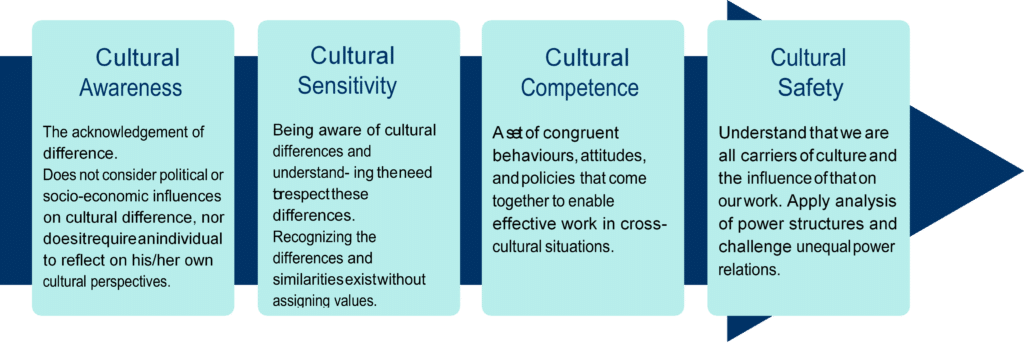When supporting mothers, it is recommended that PEACE Programs take the time to reflect and consider the ways their culture of origin may influence the work that they do. As a starting place, PEACE Program counsellors can familiarize themselves with Cultural Safety.

Figure 1: Continuum of Culturally Responsive Approaches
Culturally responsive approaches exist on a continuum, from cultural awareness to cultural safety. The above model illustrates this continuum, showing how one can move from a simple awareness of difference among cultures, to a curiosity, understanding, and reflection of one’s own cultural assumptions and biases—that influences our perceptions of, and interactions with, others.
What Is Cultural Safety?
The concept and terminology of cultural safety was developed in the 1980’s by the Maori people in New Zealand, in response to dissatisfaction with the nursing care they had received.
“Cultural safety is defined as an environment which is safe for people; where there is no assault, challenge or denial of their identity, of who they are and what they need. It is about shared respect, shared meaning, shared knowledge and experience, of learning together with dignity, and truly listening.”²
Cultural competence is a set of skills that practitioners can master, to function effectively within the context of the cultural beliefs, behaviours, and needs presented by different individuals and their communities. Instead of a “checklist” approach based on a set of cultural skills, cultural safety requires the provider to be intuitive, curious, and responsive to each individual, and to examine critically the power relations in every interaction.
Key aspects of cultural safety:
- Understanding that we are all carriers of culture, and the influence of that on our work.
- Applying analysis of power structures, and challenging unequal power relations.
- Determining success by a mother’s perception of whether the interaction is culturally safe.
- Not categorizing or labeling individuals.
- Practicing to ensure that our actions do not “diminish, demean or disempower the cultural identity and well being of an individual.” (Nursing Council of New Zealand, 2002)
Cultural Humility
In support of cultural safety, cultural humility emerged as a way to enable cultural safety. Cultural humility involves acknowledging oneself as a learner when it comes to understanding another’s experience. It is a life-long process of self-reflection aiming to understand personal and systemic biases. Cultural humility encourages individuals and organizations to develop and maintain respectful processes and relationships based on mutual trust. When PEACE Program counsellors engage with mothers from diverse communities from a place of cultural humility, they are helping to cultivate a safe environment. Thus, cultural humility is an integral part of a PEACE Program that is culturally safe for all.
Utilizing a strength-based approach, PEACE Program counsellors may reflect on the questions below to enhance cultural safety with individual mothers from diverse cultural backgrounds in the PEACE Program. These questions may help us to develop a better understanding of the systemic violence women endure and recognize some of the barriers and fears women may face when considering leaving an abusive relationship.³
- What is this mother’s language of origin? If mothers do not speak English, some of the resources listed at the end of this chapter may helpful to consult.
- What can I learn about this mother’s family of origin?
- Outside of my job as a PEACE Program counselor, what can I learn about the culture of this family through reading, outside learning and community connections?
- What does family look like and mean for this mother? Our western concept of family may be different from the mother we are supporting. Inquiring about the resource of family in the mother’s culture or country of origin may allow us to see more clearly a mother’s resources and strengths.
- What does separation and divorce look like in this mother’s culture or country of origin? Understanding this may help us to envision our role as a resource for mothers in a way that is culturally sensitive and useful.
Through engaging in these real conversations with mothers, PEACE Program counsellors can begin to increase their comfort level when connecting with and learning about the diverse experiences of mothers from many cultures, countries, and language backgrounds. Lessons in cultural safety and cultural humility do not come with a quick and easy solution, but rather inspire us to stay open to the process of learning together and creating a sense of belonging within our programs for all mothers.
Funding for this toolkit is provided for by the Ministry of Public Safety and Solicitor General.
© 2022 BC Society of Transition Houses.
This online guide, or any portion thereof, may be reproduced or used in any manner whatsoever as long as acknowledgment to the BC Society of Transition Houses is included in the product.
²Johnstone, M. & Kanitsaki, O. (2007). An exploration of the notion and nature of the construct of cultural safety and its applicability to the Australian health care context. Journal of Transcultural Nursing, 18(3), 247-256. https://doi.org/10.1177/1043659607301304
³BCSTH (2016) Building Supports. Promising Practices for Supporting Immigrant & Refugee Women Leaving Violence. Retrieved from https://bcsth.ca/projects/building-supports/